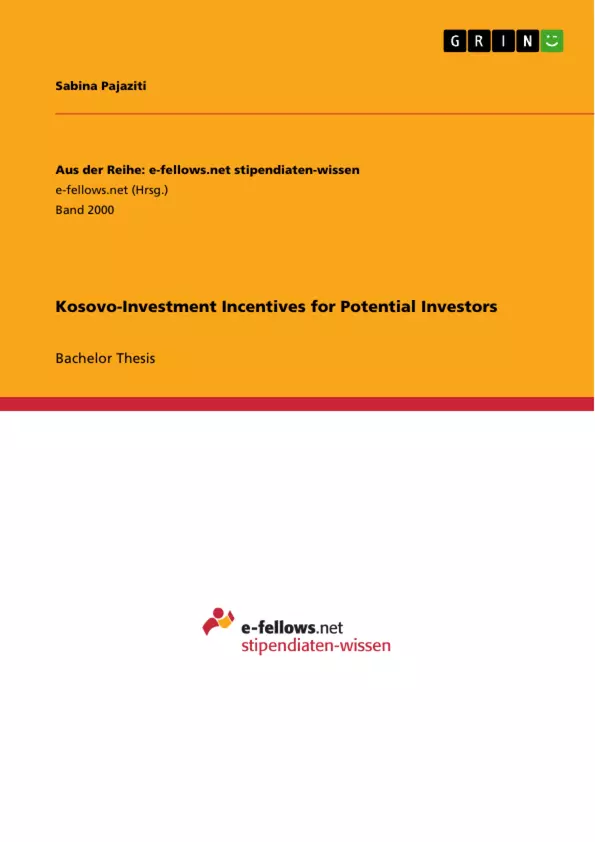There are numerous factors that have to be taken into account when investing or merely doing business abroad. Therefore, this thesis gives a description of Kosovo as a location of business for potential investors by explaining the economic and regulatory framework.
This thesis aims to point out the requirements for investing in Kosovo as well as to present the most important facts about the country in order to contribute to the decision-making process regarding investments. Furthermore, this thesis will deliver insight into the Kosovar market and its economic sectors by underlining the competitive advantages available in Kosovo. Based on this, the following chapters will present the preconditions in addition to the key decision factors aiming to contribute to a facilitation of the decision-making.
Inhaltsverzeichnis (Table of Contents)
- Preface
- Introduction
- Goal and Structure of the Thesis
- Country Overview Kosovo
- Place and People
- Historical Background
- Georeferenced Data
- Climatic Conditions
- Population
- Ethnic Groups
- Diaspora
- Religion
- Language, Currency and Time Zone
- The Political System and the Legal Framework
- Government System
- General Principles
- Political Situation
- Political Parties
- Educational System
- Government System
- Place and People
- Main Characteristics of the Kosovar Economy
- Economic Climate
- Economic Sectors
- Agriculture
- Mining and Energy
- Foreign Trade
- Trade Exchange
- Trade Agreements and Foreign Relations
- Central European Free Trade Agreement
- EU Autonomous Trade Preference
- Stabilization and Association Process
- Generalized System of Preferences
- International Monetary Fund
- Foreign Investment
- Foreign Direct Investment
- Success Stories
- Construction
- Telecommunication
- Banking
- Mining
- Foundation of an Enterprise
- Form of Organization
- Sole Proprietorship
- Limited Partnership
- Corporate Enterprise
- Limited Liability Company and Joint Stock Company
- Management and Responsibilities
- Liability of Partners
- Establishment
- Start-Up Costs
- Insolvency
- Form of Organization
- Location Factors
- Road and Railroad Network
- Air Traffic
- Electrical Power Supply
- Telecommunications Network
- Taxation Law
- Types of Taxes
- Personal Income Tax
- Corporate Income Tax
- Expenses
- Depreciations
- Tax Declaration and Payments
- Value Added Tax
- Types of Taxes
- Labour Legislation and Standards
- Labour Market Indicators
- Employment Relations
- Labour Contract
- Working Hours
- Annual Leave
- Sick Leave
- Legal Holidays
- Costs of Labour
- Intercultural Management
- Cultural Aspects
- Corruption
Zielsetzung und Themenschwerpunkte (Objectives and Key Themes)
This thesis aims to provide a comprehensive overview of Kosovo's investment landscape, presenting relevant information for potential investors. It explores the country's economic climate, legal framework, and key industry sectors while examining the incentives available to attract foreign investment.
- Country Overview of Kosovo
- Kosovo's Economic Climate and Investment Opportunities
- The Legal Framework for Investing in Kosovo
- Key Industry Sectors and Growth Potential
- Challenges and Opportunities for Foreign Investors
Zusammenfassung der Kapitel (Chapter Summaries)
The thesis begins with a detailed overview of Kosovo, covering its geography, history, population, and political system. The second chapter delves into the key characteristics of the Kosovar economy, analyzing economic sectors like agriculture, mining, and energy. This section also explores the dynamics of foreign trade, including trade agreements, foreign investment patterns, and success stories.
Following this, the thesis focuses on the foundation of an enterprise in Kosovo, outlining the different forms of organization and the associated legal requirements. It also examines the start-up costs, the process of establishment, and the potential implications of insolvency. The fifth chapter focuses on the location factors relevant to investors, analyzing Kosovo's infrastructure, including its road and railroad network, air traffic, electricity supply, and telecommunications network.
Chapter six provides a comprehensive analysis of Kosovo's taxation law, exploring the types of taxes, personal and corporate income tax rates, and value-added tax. The subsequent chapter examines labor legislation and standards, covering labor market indicators, employment relations, working hours, and costs of labor. Finally, the thesis concludes with a discussion on intercultural management, emphasizing the importance of understanding cultural aspects and potential challenges related to corruption in the Kosovar context.
Schlüsselwörter (Keywords)
The thesis focuses on key themes like investment incentives, foreign direct investment, economic development, legal framework, industry sectors, location factors, taxation, labor legislation, and intercultural management. It examines Kosovo's investment landscape from a comprehensive perspective, providing insights for potential investors seeking to understand the opportunities and challenges of doing business in this emerging market.
- Citation du texte
- Sabina Pajaziti (Auteur), 2011, Kosovo-Investment Incentives for Potential Investors, Munich, GRIN Verlag, https://www.grin.com/document/335782



